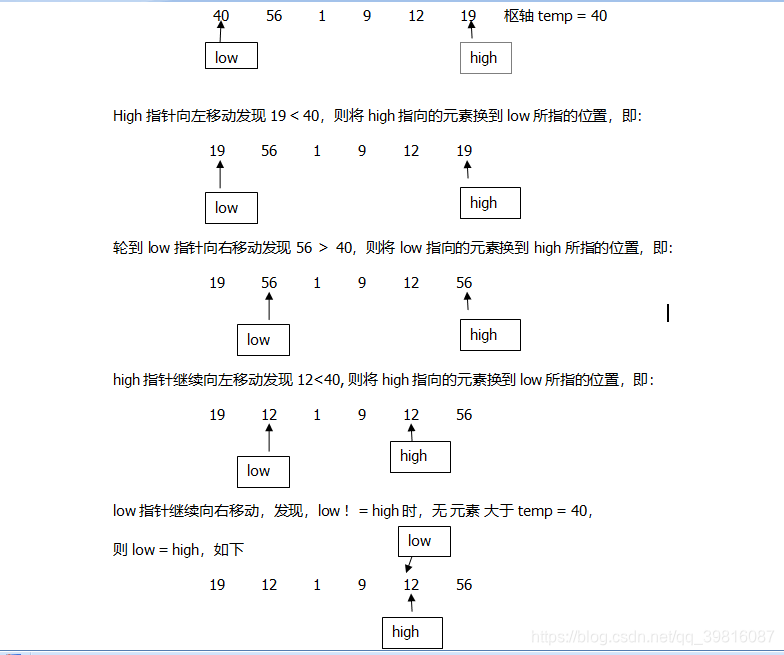快速排序在枢轴的确定上有很多方式,该篇只是讨论基本的快速排序思想,默认首个元素即为枢轴。待日后对其进行学习补充。欢迎讨论学习。凌晨两点写完的稿,难免会有错别字,敬请谅解。
原始数据:
左边 40 56 1 9 12 19 右边
一趟排序过程:

一趟排序完成:
19 12 1 9 40 56
根据上述排序过程,写出下列代码:
#include<iostream>
#include<cstdio>
using namespace std;
void quickSort(int *arr, int begin, int end);
int getIndex(int *arr, int low, int high);
void show(int *arr, int N){
for(int i = 0; i < N; i ++){
cout<<arr[i]<<"\t";
}
cout<<endl;
}
int main(void){
int arr[6] = { 40, 56, 1, 9, 12, 19};
cout<<"原始数组:"<<endl;
show( arr, 6);
cout<<endl<<"排序过程:"<<endl<<endl;
quickSort( arr, 0, 5);
cout<<"排序过后的数组:"<<endl;
show( arr, 6);
return 0;
}
void quickSort(int *arr, int begin, int end){
if(begin >= end) return;
// 获取上一次排序枢轴位置(即就是 排序位置确定的元素位置)
int index = getIndex( arr, begin, end);
cout<<"完成1次排序后的数组结果:"<<endl;
show(arr,6);
cout<<endl<<endl;
//对枢轴左边的数据进行递归排序
quickSort( arr, begin, index - 1);
//对枢轴右边的数据进行递归排序
quickSort( arr, index + 1, end);
}
int getIndex(int *arr, int low, int high){
int temp = arr[low];
while(low < high){
// 从最右端开始向左找到小于枢轴的元素
while(low < high && arr[high] >= temp){
high --;
}
arr[low] = arr[high];//将 high指针 指向的小于枢轴的元素交换到 low指针 所指的位置
// 打印数组元素的变化情况
cout<<"low: "<<low<<" high: "<<high<<" 元素变化:";
show(arr,6);
// 从最右端开始想右找到大于枢轴的元素
while(low < high && arr[low] <= temp){
low ++;
}
arr[high] = arr[low];//将 low指针 指向的大于枢轴的元素交换到 high指针 所指的位置
// 打印数组元素的变化情况
cout<<"low: "<<low<<" high: "<<high<<" 元素变化:";
show(arr,6);
}
cout<<"将 枢轴:"<<temp<<" 替代找到的位置的元素:"<<endl;// 为了显示过程是否正确
arr[low] = temp;
return low;
}
运行结果:






 本文通过一个具体的例子详细介绍了快速排序的基本思想及其实现过程,并提供了一段C++代码来实现快速排序,展示了排序的过程和结果。
本文通过一个具体的例子详细介绍了快速排序的基本思想及其实现过程,并提供了一段C++代码来实现快速排序,展示了排序的过程和结果。
















 253
253

 被折叠的 条评论
为什么被折叠?
被折叠的 条评论
为什么被折叠?








